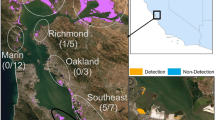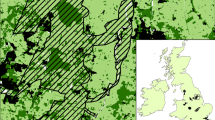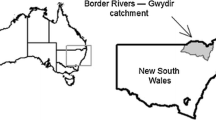Abstract
Conservation of populations in fragmented habitats is often based on spatially realistic metapopulation theory, which predicts negative relationships between patch extinction and area and patch colonization and isolation. Cost-distance metrics have been developed to integrate habitat quality into measures of connectivity, and thus may improve predictive power of the area-isolation paradigm. Few studies use empirical data to compare predictive performance of complex cost-distance metrics to simple metrics relying on Euclidean distances. We used 3 years of presence–absence data to examine relative influence of habitat quality, habitat area, and connectivity on occupancy and extinction rates for Poliocitellus franklinii (Franklin’s ground squirrel), a rare grassland species of conservation concern. We calculated connectivity using nearest-neighbor (NN) and incidence function model (IFM) metrics based on Euclidean and cost-distances. Habitat quality, area, and connectivity were all positive predictors for occupancy, but only isolation was a positive predictor of extinction. P. franklinii does not appear to be a tallgrass prairie obligate, but the species distribution is limited by isolation of suitable grassland habitat. A simple NN metric measuring Euclidean distance between a target area and nearest occupied source outperformed IFM (Euclidean and cost-distance) in predicting occupancy and extinction for P. franklinii. Although NN metrics are criticized for considering only the contribution of the source nearest to a target, this simplicity may be acceptable when measuring connectivity for rare species with few occupied habitat patches within dispersal distance.




Similar content being viewed by others
References
Bender DJ, Tischendorf L, Fahrig L (2003) Using patch isolation metrics to predict animal movement in binary landscapes. Landscape Ecol 18:17–39
Benedict RA, Freeman PW, Genoways HH (1996) Prairie legacies—mammals. In: Samson FB, Knopf FL (eds) Prairie conservation: preserving North America’s most endangered ecosystem. Island Press, Washington, DC, pp 149–166
Brown JH, Kodric-Brown A (1977) Turnover rates in insular biogeography: effect of immigration on extinction. Ecology 58:445–449
Burnham KP, Anderson DR (2002) Model selection and multimodel inference: a practical information-theoretic approach, 2nd edn. Springer-Verlag, New York
Calabrese JM, Fagan WF (2004) A comparison-shopper’s guide to connectivity metrics. Front Ecol Environ 2:529–536
Chardon JP, Adriaensen F, Matthysen E (2003) Incorporating landscape elements into a connectivity measure: a case study for the speckled wood butterfly (Parargeaegeria L.). Landscape Ecol 18:561–573
Choromanski-Norris J, Fritzell EK, Sargeant AB (1989) Movement and habitat use of Franklin’s ground squirrels in duck-nesting habitat. J Wildl Manag 53:324–331
Cosentino BJ, Schooley RL, Phillips CA (2010) Wetland hydrology, area, and isolation influence spatial turnover of the painted turtle, Chrysemys picta. Landscape Ecol 25:1589–1600
Etherington TR (2011) Python based GIS tools for landscape genetics: visualizing genetic relatedness and measuring landscape connectivity. Methods Ecol Evol 2:52–55
Fagan WF, Calabrese JM (2006) Quantifying connectivity: balancing metric performance with data requirements. In: Crooks KR, Sanjayan M (eds) Connectivity conservation. Cambridge University Press, Cambridge, pp 297–317
Fargione JE, Cooper TR, Flaspohler DJ, Hill J, Lehman C, McCoy T, McLeod S, Nelson EJ, Oberhauser KS, Tilman D (2009) Bioenergy and wildlife: threats and opportunities for grassland conservation. Bioscience 59:767–777
Ferreras P (2001) Landscape structure and asymmetrical interpatch connectivity in a metapopulation of the endangered Iberian lynx. Biol Conserv 100:125–136
Fleishman E, Ray C, Sjögren-Gulve P, Boggs CL, Murphy DD (2002) Assessing the roles of patch quality, area, and isolation in predicting metapopulation dynamics. Conserv Biol 16:706–716
Frank K, Wissel C (1998) Spatial aspects of metapopulation survival—from model results to rules of thumb for landscape management. Landscape Ecol 13:363–379
Franken RJ, Hik DS (2004) Influence of habitat quality, patch size and connectivity on colonization and extinction dynamics of collared pikas Ochotona collaris. J Anim Ecol 73:889–896
Gee GW, Bauder JW (1979) Particle size analysis by hydrometer: a simplified method for routine textural analysis and a sensitivity test of measurement parameters. Soil Sci Soc Am J 43:1004–1007
Haberman CG, Fleharty ED (1972) Natural history notes on Franklin’s ground squirrel in Boone County, Nebraska. Trans Kans Acad Sci 74:76–80
Hanski I (1994) A practical model of metapopulation dynamics. J Anim Ecol 63:151–162
Hanski I, Gaggiotti OE (eds) (2004) Ecology, evolution, and genetics of metapopulations. Academic Press, San Diego
Helgen KM, Cole FR, Helgen LE, Wilson DE (2009) Generic revision in the Holarctic ground squirrel genus Spermophilus. J Mammal 90:270–305
Huebschman JJ (2007) Distribution, abundance, and habitat associations of Franklin’s ground squirrel (Spermophilus franklinii Sabine 1822). Ill Nat Hist Surv Bull 38:1–57
Jaquiéry J, Guélat J, Broquet T, Berset-Brändli L, Pellegrini E, Moresi R, Hirzel AH, Perrin N (2008) Habitat-quality effects on metapopulation dynamics in greater whitetoothed shrews, Crocidura russula. Ecology 89:2777–2785
Johnson SA, Choromanski-Norris J (1992) Reduction in the eastern limit of the range of the Franklin’s ground squirrel (Spermophilus franklinii). Am Midl Nat 128:325–331
Justus M, Witte L, Hartmann T (1997) Levels and tissue distribution loline alkaloids in endophyte-infected Fetusca pratensis. Phytochemistry 44:51–57
Kaufman SR, Kaufman W (2007) Invasive plants: a guide to identification and the impacts and control of common North American species. Stackpole Books, Mechanicsburg
Kirt RR (1998) Prairie plants of the Midwest: identification and ecology, 4th edn. Stipes, Champaign
MacKenzie DI, Nichols JD, Royle JA, Pollock KH, Bailey LL, Hines JE (2006) Occupancy estimation and modeling. Academic Press, San Diego
Magle SB, Theobald DM, Crooks KR (2009) A comparison of metrics predicting landscape connectivity for a highly interactive species along an urban gradient in Colorado, USA. Landscape Ecol 24:267–280
Martin JM, Heske EJ (2004) Cover and soil drainage influence burrow location of Franklin’s ground squirrel (Spermophilus franklinii) in Champaign County, Illinois. Trans Ill State Acad Sci 97:227–233
Martin JM, Heske EJ (2005) Juvenile dispersal of Franklin’s ground squirrel (Spermophilus franklinii) from a prairie “island”. Am Midl Nat 153:444–449
Martin JM, Heske EJ, Hofmann JE (2003) Franklin’s ground squirrel in Illinois: a declining prairie mammal? Am Midl Nat 150:130–138
Mills LS (2006) Conservation of wildlife populations: demography genetics and management. Blackwell, Oxford
Moilanen A, Nieminen M (2002) Simple connectivity measures in spatial ecology. Ecology 83:1131–1145
Murie JO (1999) Franklin’s ground squirrel, Spermophilus franklinii. In: Wilson DE, Ruff S (eds) The Smithsonian book of North American mammals. Smithsonian Institution Press, Washington, DC, pp 419–420
National Oceanic and Atmospheric Administration (NOAA) (2010) National Climatic Data Center. Daily temperature and precipitation data. http://www7.ncdc.noaa.gov/IPS/coop/coop.html. Accessed Sept 2010
Ogle L, St. John L, Jensen K (2010) Species selection and grazing management guidelines. In: Shewmaker GE, Bohle MG (eds) Pasture and grazing management in the Northwest, PNW 614. University of Idaho Extension, Moscow, pp 7–20
Ovaskainen O, Hanski I (2001) Spatially structured metapopulation models: global and local assessment of metapopulation capacity. Theor Popul Biol 60:281–302
Ovaskainen O, Hanski I (2004) Metapopulation dynamics in highly fragmented landscapes. In: Hanski I, Gaggiotti OE (eds) Ecology genetics and evolution of metapopulations. Elsevier Academic Press, Burlington, pp 73–103
Pellet J, Fleishman E, Dobkin DS, Gander A, Murphy DD (2007) An empirical evaluation of the area and isolation paradigm of metapopulation dynamics. Biol Conserv 136:483–495
Pergams ORW, Nyberg D (2001) Museum collections of mammals corroborate the exceptional decline of prairie habitat in the Chicago region. J Mammal 82:984–992
Prugh LR (2009) An evaluation of patch connectivity measures. Ecol Appl 19:1300–1310
Prugh LR, Hodges KE, Sinclair ARE, Brashares JS (2008) Effect of habitat area and isolation on fragmented animal populations. Proc Natl Acad Sci USA 105:20770–20775
Ricketts TH (2001) The matrix matters: effective isolation in fragmented landscapes. Am Nat 158:87–99
Samson F, Knopf F (1994) Prairie conservation in North America. Bioscience 44:418–421
Schooley RL, Branch LC (2009) Enhancing the area-isolation paradigm: habitat heterogeneity and metapopulation dynamics of a rare wetland mammal. Ecol Appl 19:1708–1722
Sherman PW, Runge MC (2002) Demography of a population collapse: the Northern Idaho ground squirrel (Spermophilus brunneus brunneus). Ecology 83:2816–2831
Sikes RS, Gannon WL, The Animal Care and Use Committee of the American Society of Mammalogists (2011) Guidelines of the American Society of Mammalogists for the use of wild mammals in research. J Mammal 92:235–253
Southworth J, Randolph JC, Habeck M, Doering OC, Pfeifer RA, Rao DG, Johnston JJ (2000) Consequences of future climate change and changing climate variability on maize yields in the midwestern United States. Agric Ecosyst Environ 82:139–158
Sutherland GD, Harestad AS, Price K, Lertzman KP (2000) Scaling of natal dispersal distances in terrestrial birds and mammals. Conserv Ecol 4:16. http://www.consecol.org/vol4/iss1/art16. Accessed Sept 2010
Tischendorf L, Fahrig L (2000) On the usage and measurement of landscape connectivity. Oikos 90:7–19
U.S. Soil Conservation Service (1975) Engineering field manual for conservation practices. U.S. Government Printing Office, Washington, DC
Verbeylen G, De Bruyn L, Adriaensen F, Matthysen E (2003) Does matrix resistance influence red squirrel (Sciurus vulgaris L. 1758) distribution in an urban landscape? Landscape Ecol 18:791–805
Wilcove DS, Rothstein D, Dubow J, Phillips A, Losos E (1998) Quantifying threats to imperiled species in the United States. Bioscience 48:607–615
Acknowledgments
We thank the Indiana DNR for sharing trapping data. We are grateful to D. Bautz, J. Flinn, and S. Ingram for assistance finding historical locations of P. franklinii and to managers of Barnhart Prairie Nature Preserve, Bilby Ranch Lake Conservation Area, Scuppernong Prairie State Natural Area, and private landowners for allowing access to properties. We are especially grateful to N. Karniski, M. McNicoll, J. Nachel, H. Pioch, J. Strand, and L. Ziccarelli for field assistance and R. Darmody for help with soil particle analyses. This project was funded by the Illinois DNR through the Federal Aid in Wildlife Restoration Program (Project W-152-R), University of Illinois, Illinois State Academy of Sciences, American Society of Mammalogists, and American Museum of Natural History.
Author information
Authors and Affiliations
Corresponding author
Electronic supplementary material
Below is the link to the electronic supplementary material.
Rights and permissions
About this article
Cite this article
Duggan, J.M., Schooley, R.L. & Heske, E.J. Modeling occupancy dynamics of a rare species, Franklin’s ground squirrel, with limited data: are simple connectivity metrics adequate?. Landscape Ecol 26, 1477–1490 (2011). https://doi.org/10.1007/s10980-011-9652-9
Received:
Accepted:
Published:
Issue Date:
DOI: https://doi.org/10.1007/s10980-011-9652-9




